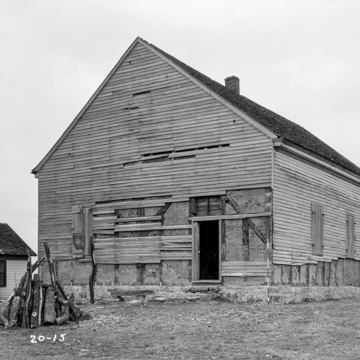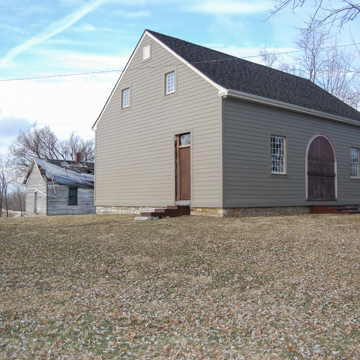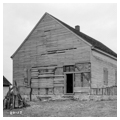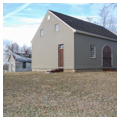You are here
Old Mud Meeting House
Old Mud Meeting House provides an impressive counterpoint to the view of early Kentucky architecture as the product of Virginian and English impulses. A colony of migrants from Holland made their way to Kentucky in the eighteenth century, moving through Long Island, New Jersey, and finally Pennsylvania, before arriving in Mercer County with their own customs, language, and a distinctive building technique. The Synod of the Dutch Reformed Church sent the Reverend Peter Labagh to Harrodsburg in 1796 to establish a church. He returned to Hackensack, New Jersey, long enough to raise funds to purchase land in Mercer County, ultimately buying a site on the dry fork of the Salt River from David and Elizabeth Adams.
The Dutch migrants built Old Mud in 1800 on a limestone foundation with exposed vertical timbers. It measures 46’4” x 34’4” and has sixteen roof trusses riding on collar beams, and four tie beams linking alternate pairs of wall posts. The church’s featured hand-hewn heavy timber framework, mortise-and-tenon joinery, and wattle-and-daub walls. This building technique was used in dozens of Mercer County residences of the time, especially in the houses of Dutch settlers who worshiped at Old Mud. By the 1830s, assimilation and technical innovations, such as dimension lumber and balloon framing, began to erode these traditions, but sixty-one such structures survived long enough to be documented in the twentieth century. Those that were not torn down were frequently covered in clapboard to hide a building’s pioneer origins: this was the case with Old Mud. In 1849 church members affixed clapboards to the exterior, plastered the interior walls, and cut taller window openings. They also changed the entry by sealing off its south-side door and cutting a new pair of doors on the east gable side. Thus Old Mud became indistinguishable from the two-door churches typical of the antebellum architecture of the Bluegrass.
The building has been well documented over the years: first by the Historic American Buildings Survey in 1934 and again by architectural historian Clay Lancaster in 1981. When deterioration of the walls under the clapboards was discovered in the early 2000s, new siding was attached to Old Mud’s exterior.
Old Mud stands three miles southwest of Harrodsburg, the first town established in in what would become Kentucky (in 1755). It is the first Dutch Reformed Church built west of the Alleghenies. The Harrodsburg Historical Society operates Old Mud Meeting House, which is open to the public by appointment only.
References
Lancaster, Clay. “Dutch Reformed Church Meeting House.” Survey form, on file, Frankfort, Kentucky Heritage Council, 1981.
Thomas, James C., “Dutch Reform Church,” Mercer County, Kentucky. National Register of Historic Places Inventory-Nomination Form, 1972. National Park Service, U.S. Department of the Interior, Washington, D.C.
Toadvine, Emily. “Restoration of Mud Meeting House Requires Lot of Work.” Central Kentucky News, September 8, 2003.
Writing Credits
If SAH Archipedia has been useful to you, please consider supporting it.
SAH Archipedia tells the story of the United States through its buildings, landscapes, and cities. This freely available resource empowers the public with authoritative knowledge that deepens their understanding and appreciation of the built environment. But the Society of Architectural Historians, which created SAH Archipedia with University of Virginia Press, needs your support to maintain the high-caliber research, writing, photography, cartography, editing, design, and programming that make SAH Archipedia a trusted online resource available to all who value the history of place, heritage tourism, and learning.




